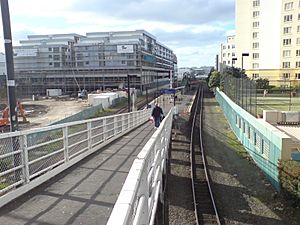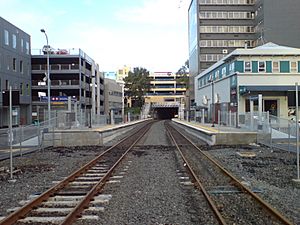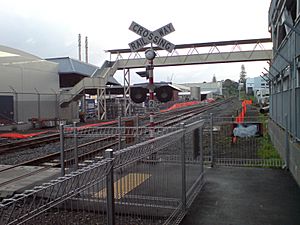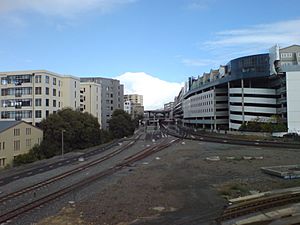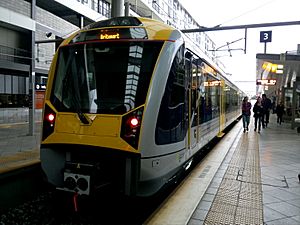Newmarket railway station, Auckland facts for kids
Quick facts for kids
Newmarket
|
||||||||||||||||||||||
|---|---|---|---|---|---|---|---|---|---|---|---|---|---|---|---|---|---|---|---|---|---|---|
| Auckland Transport Urban rail | ||||||||||||||||||||||
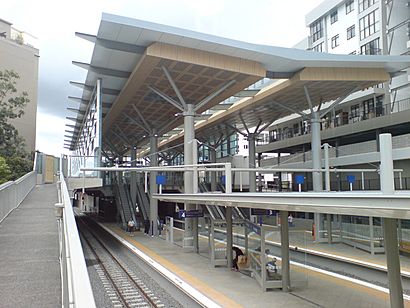
An overview of Newmarket Station shortly after its redevelopment.
|
||||||||||||||||||||||
| Location | Newmarket, Auckland | |||||||||||||||||||||
| Coordinates | 36°52′11″S 174°46′44″E / 36.869626°S 174.778882°E | |||||||||||||||||||||
| Owned by | KiwiRail (track and platforms) Auckland Transport (buildings) |
|||||||||||||||||||||
| Line(s) | North Auckland Line Newmarket Line |
|||||||||||||||||||||
| Platforms | Island platforms, 180m | |||||||||||||||||||||
| Tracks | Mainline (2), Other (1) |
|||||||||||||||||||||
| Construction | ||||||||||||||||||||||
| Platform levels | 1 | |||||||||||||||||||||
| Parking | No | |||||||||||||||||||||
| Bicycle facilities | Yes | |||||||||||||||||||||
| Other information | ||||||||||||||||||||||
| Station code | NWT | |||||||||||||||||||||
| Fare zone | City/Isthmus (overlap) | |||||||||||||||||||||
| History | ||||||||||||||||||||||
| Opened | 1873 | |||||||||||||||||||||
| Closed | January 2008 | |||||||||||||||||||||
| Rebuilt | January 2008 - 2010 | |||||||||||||||||||||
| Electrified | 25 kV AC | |||||||||||||||||||||
| Previous names | Newmarket Junction | |||||||||||||||||||||
| Traffic | ||||||||||||||||||||||
| Passengers (CY 2018) | 2,560,428 | |||||||||||||||||||||
| Services | ||||||||||||||||||||||
|
||||||||||||||||||||||
The Newmarket railway station is a busy train station in the Newmarket area of Auckland, New Zealand. It's a key stop on Auckland's train network, serving the Southern, Onehunga, and Western Lines. After Britomart, it's the second busiest station in Auckland.
The station first opened in 1873. It was completely rebuilt between 2008 and 2010. The new station has two platforms, three tracks, and a concourse (a large open area) above the platforms. The modern station officially opened on 14 January 2010.
Contents
Station History
The Original Station
The first Newmarket station opened in 1873. It had one platform shaped like an island, which you could reach by a ramp from Remuera Road. There was also a bridge for people to walk over, connecting to Broadway.
The original station building was built in 1908. It was designed by George Troup, a famous engineer for the New Zealand Railways. A special building called a signal box was also built nearby. This box helped control the train signals and tracks. It was one of the last old-style signal boxes still working in the late 1900s.
Newmarket was also home to the Newmarket Workshops, which opened in 1878. These workshops were where trains were repaired and maintained. They closed in 1927 when bigger workshops opened in Otahuhu.
Confusing Train Movements
The old station was near a junction where the Western and Southern train lines met. This caused some tricky train movements. Trains coming from the city had to pass the junction before stopping at the station.
The station had two platforms. All trains going towards the city stopped at one platform. Trains leaving the city stopped at the other. This could be confusing because the platform for outbound trains served both the Southern and Western Lines. To help, the platform was sometimes "split." Southern Line trains stopped at one end, and Western Line trains at the other. But the platform was short, so this didn't always fix the confusion.
Later, trains started using whichever platform was free, especially during busy times. This made it even harder for passengers to know which train was going where. Station staff often used megaphones to tell people which train was for which line.
What was the 'Backshunt'?
For many years, trains on the Western Line that were leaving the station had to do a special "backshunt." This meant they would reverse into a side track, then move forward onto the Western Line. This process added a few minutes to each trip. Even after the station was rebuilt and electric trains arrived, this backshunt process continued.
Saving the Old Station Building
The old station building was very important because of its history and design. There was a lot of discussion about what to do with it. Some people wanted to knock it down, others wanted to fix it up, and some wanted to move it.
In 2007, it was decided that the building would be moved. It was taken apart and stored safely in March 2008. This was done to protect it from damage. The old station building was later moved to Parnell station. It now serves as the station building there, opening for services in March 2017.
A Brand New Station!
Newmarket station was completely rebuilt between January 2008 and January 2010. This big project cost about NZ$35 million. During the rebuild, the station had to close. Two temporary stations were set up nearby: Newmarket South on the Southern Line and Newmarket West on the Western Line. Both temporary stations were later taken down.
The new station was designed to be modern and connect better with the surrounding shops and homes. It now has a concourse (a large hall) above the train platforms. You can enter the station from a new square off Broadway, a long covered bridge from Remuera Road, and a pedestrian bridge from Joseph Banks Terrace.
When the new station opened, some people noticed that the step up into the trains was quite high. This was designed this way so that freight trains could still pass through the station. Authorities explained that this height was similar to most other stations in Auckland. The step height would be less of an issue with the new electric trains, which are designed for the Auckland network.
New Track Layout and Platforms
A big part of the rebuild was changing how the train tracks were laid out. The new station has two "island" platforms and three tracks. Each island platform has two sides, making four platform faces in total.
- Platform One usually serves trains going west on the Western Line.
- Platform Three serves trains going towards Britomart on all three lines (Western, Onehunga, and Southern).
- Platform Four serves trains going south on the Onehunga and Southern Lines.
The station rebuild cost about NZ$25 million. Changing the track layout cost another NZ$45 million. This project was one of the most challenging parts of upgrading Auckland's railway network.
Easy Ways to Get Around
The main entrance from the concourse leads to Station Square. This is a large open area on the western side of the station. It connects to Broadway and Remuera Road through covered walkways. There's also a covered bridge from the concourse to Remuera Road to the south. Another smaller bridge connects to Joseph Banks Terrace on the east side. There are plans for a future entrance to Broadway, near the Olympic Pools.
On 27 April 2014, Auckland's new AM class electric trains were shown to the public. There was a special open day at Britomart Transport Centre. Thousands of Aucklanders got to take a free ride on one of the new electric trains from Britomart to Newmarket station and back.
The electric trains officially started carrying passengers on the Onehunga Line the very next day.
Awards for Design
The lighting design for Newmarket station won three awards in 2010. These awards were given by Opus International Consultants, the engineers who designed the lighting. They won for their excellent and innovative LED lantern box design on Remuera Road.
In 2011, the station and its architects, Opus and Herriot + Melhuish:Architecture, won a "best building" award. This was in the "Urban Design" category from the New Zealand Institute of Architects.
Services
Transdev Auckland, working for Auckland Transport, runs the train services through Newmarket. You can catch trains to Britomart, Swanson, Onehunga, Papakura, and Pukekohe from Newmarket.
During the middle of the day on weekdays, trains run often:
- 8 trains per hour (tph) go to Britomart from Swanson, Papakura, and Onehunga.
- 3 tph go to Swanson.
- 3 tph go to Papakura.
- 2 tph go to Onehunga.
Several bus routes also pass close to Newmarket station. These include routes 30, 70, 75, 295, 309, 751, 781, the Inner Link, and the Outer Link.


